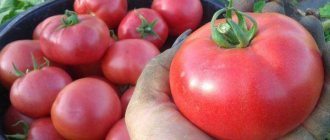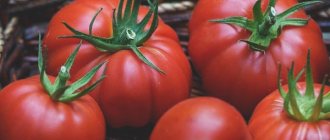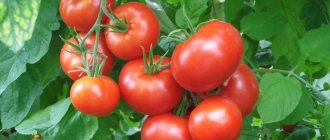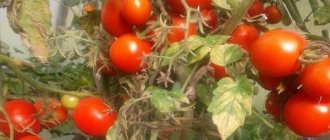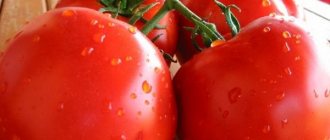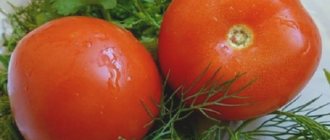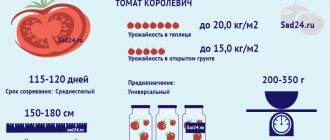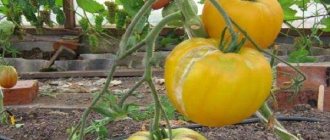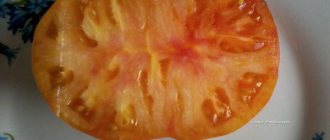Tomato Malika F1 - description and characteristics of the variety
Tomato Malika F1 is a hybrid bred for cultivation both in greenhouse conditions and in open ground. It has become widespread in Russia, Moldova, and Ukraine. Belongs to early ripening varieties. Mature fruits are formed already on the 108th day after the appearance of the first shoots.
Characteristics of the variety
Ripe tomatoes have a bright, red color. They lack the greenish color near the stem found in most other tomatoes. The fruits have a round shape, slightly flattened on both sides: on top of the tomato and below. There is always ribbing on the surface. The peel is dense and smooth.
Each tomato has many chambers with seeds inside and fleshy, juicy pulp. The weight of one fruit can reach 275 grams. Due to its density, the skin of the fruit is resistant to cracks and external damage.
The variety belongs to the indeterminate type, which means that it requires pinching, since the growth of the plant is unlimited. It can reach a considerable height. Typically, the first inflorescence appears above 5-6 leaves and produces 8 to 10 fruits. In one season, it is possible to collect from 1 m2 to about 18 kg of fruit.
The variety is powerful and massive thanks to a well-developed root system that nourishes the entire plant. Shrubs are resistant to weather variability and tolerate low temperatures well. Despite unfavorable conditions, the variety produces a high and high-quality harvest. In general, tomatoes have good immunity to both diseases and pests.
These tomatoes can be grown for sale: they tolerate transportation well and retain their external and taste qualities. The shelf life of this variety is slightly lower than other varieties - only two weeks. It is also worth considering that Malika fruits are consumed only in fresh, unprocessed form.
Landing Features
When the first leaves appear, you can plant them in separate containers. And then - to a permanent place of growth. Depending on climatic conditions, these times may vary. An important condition for planting is the end of frost. The soil should be warm, well heated by the sun's rays.
When planting, it is necessary to maintain a certain distance: half a meter between bushes, and 40 cm between rows. One m2 can accommodate from 3 to 4 plants.
When choosing a site for the constant growth of tomatoes, you must take into account what crop grew on it before. It is recommended to plant Malika tomatoes in an area where the following crops grew:
Growing
- timely watering;
- weed removal;
- loosening the soil.
These three procedures are enough to get a good harvest.
Before planting seedlings in a hole, it is recommended to add some organic matter and ash to it. During the growing period, you can use “feeding” with minerals.
Diseases and pests
The Malika variety, like many hybrids, has excellent immunity to pests and various diseases characteristic of vegetable crops. It is not affected by rot, fungi, or other viruses. This ensures a good, constant, high-quality harvest and the opportunity to grow a truly environmentally friendly product, since the variety does not require treatment with various pesticides that are used against pests, against damage by fungi, viruses and other pathogenic microorganisms.
The Malika F1 tomato variety is a worthy choice for growing both outdoors and indoors. The growing process and care are quite simple. Any vegetable grower, both with many years of experience and those who want to try their hand at growing tomatoes for the first time, can get a good and high-quality harvest.
Growing Issues
When growing Malika f1 tomatoes, no special conditions are required. Timely watering, loosening the soil and removing weeds is enough. It is recommended to feed the plants with mineral fertilizers during cultivation. And during planting, you can add a handful of organic fertilizers and ash into the hole.
The tomato bush has medium foliage. They are tall, but have small internodes. To avoid broken stems, it is recommended to grow them vertically using a support or stretched trellis.
Planting process
Before planting in the soil, seeds must be disinfected for 20 minutes in a pale solution of potassium permanganate. They are then washed under the tap and sown. Treatment with stimulants is not required. Seedlings are planted in pots with a diameter of 5-7 cm. They are planted in the garden when the threat of frost has passed. The ridge is filled with organic matter and mineral fertilizers - then fertilizing during the growing season will not be needed.
Early maturing / Low growing
User rating: 5/5
Ultra-early / Low-growing
User rating: 5/5
Ultra-early / Low-growing
Growing cherry varieties is not difficult. Even a novice gardener can cultivate them on their own plot; some varieties, such as Thumb Boy, are even suitable for growing at home in an apartment. Seeds begin to be sown approximately from the fifteenth of March. Before planting the seeds in the ground, they need to be treated with a weak solution of potassium permanganate, and then rinsed with clean water.
The height of the bushes, depending on the variety, varies from 40 to 100 cm. The plant does not require special care; the tallest bushes need to be tied up if they grow in open areas so that the crown does not break. Regular weeding, removal of weeds near the crop, picking and loosening of the soil are required. When grown in an open area, pinching does not occur.
For fertilizer, mineral mixtures diluted in water are used a couple of times a month. Watering is carried out twice in seven days. During drought, the number of waterings should be increased up to 5 times. Plants produce good growth at moderate soil moisture, about 36%. Good yield is maintained at temperatures from 19 to 26 degrees.
Tomato Pablo: variety description, yield and cultivation with photos
Tomato lovers will appreciate the fruit of modern selection - the Pablo f1 tomato. Numerous advantages have ensured that the variety is in demand among gardeners in different regions of Russia. The originator of the plant was the Japanese company Sakata, and today the new product was officially entered into the state register.
General information about tomato
The Pablo variety of tomato is suitable for growing in greenhouses and open beds. Description of the appearance and characteristics of the plant:
- early ripening, the period before harvest is 95 days;
- indeterminate, has unlimited growth;
- tall, reaches 2 meters;
- powerful root system;
- good foliage;
- slightly ribbed;
- average yield, over the summer they get up to 4 kg per 1 sq. meters of landing;
- the number of fruits in the cluster is 5-6 pieces;
- good adaptive abilities;
- ease of care;
- resistance to most diseases of the nightshade family;
- possibility of transportation over long distances without loss of presentation;
- keeping quality.
Tomatoes have become a novelty among hybrid varieties. The ability to bear fruit in unfavorable weather conditions and poor soils has made it possible to grow tomatoes in all regions of Russia. Technical data and appearance of the fruit:
- flat-round, leveled shape;
- dense;
- thin skin;
- large, average weight 200 grams;
- red color when ripe;
- sweet taste;
- fleshy, not watery;
- fragrant.
Recommendations for cultivation
The plant prefers the seedling method of planting. Preparatory work begins 2 months before the expected planting date. When preparing seedlings, it is recommended:
- sow seeds to a depth of 1-1.5 cm;
- after planting, cover the containers with film;
- maintain temperature 21-25 degrees;
- after the sprouts appear, remove the film, transplant the tomatoes into separate pots and move them to the light;
- regular watering;
- picking.
IMPORTANT! Before planting, seedlings should be hardened
For 1 sq. Place no more than four tomatoes per meter of land according to a 40 x 60 cm pattern. The plant is undemanding; mandatory care measures include:
- watering with water not lower than the air temperature;
- feeding with complex mineral fertilizer, at least 4 times during the summer period;
- regular loosening and weeding of the soil;
- pinching, forming a bush into one stem;
- installation of supports and tying to the trellis with synthetic materials.
Gardeners' opinion
Good afternoon. I've heard positive reviews about Pablo's tomato. This summer I tried to grow it and was pleased.
The tomato bore fruit in the cold summer, withstood all unfavorable conditions, and had good yields. Suitable for cultivation in the northern regions of Russia. There were no difficulties in care. In greenhouse conditions I received 3 kilograms of berries from 1 sq. meters of landing. I recommend!
Valerian Egorovich, 54 years old.
Good afternoon! I recommend the Pablo variety to all tomato lovers. It tolerates heat well and does not require close attention. Suitable for growing in open ground in the southern regions of Russia. Ripe berries are suitable for salads, twists and pickles.
Reviews
Irina, Perm region
Although many reviews about the Malik f1 tomato are positive, I can talk about their shortcomings. Of course, the high cost of seeds is upsetting, and it is impossible to obtain full-fledged planting material from your harvest.
Also, bushes with trusses of 3-4 tomatoes grew in my garden bed, instead of the promised 6-10 pieces. In terms of taste, they, like all hybrids, do not have high taste qualities. But I believe that by growing these tomatoes, even under unfavorable weather conditions, you will not be left without a harvest.
Description of the tomato variety Milashka, its characteristics and yield
For lovers of cherry tomatoes and simply small fruits for rolling and fresh use, the Milashka tomato is offered on the market. It is easy to care for and produces an excellent harvest with proper care. Let's consider the characteristics of the bush, growing rules and reviews from gardeners.
Characteristics of tomato
This is an early determinate variety. From the first shoots to the first harvest, it takes from 85 to 92 days. The bushes are resistant to cold weather. The height does not exceed 50 centimeters, the bush is medium in size, the leaves are small and green.
The tomato is intended for growing in open and closed areas. Doesn't require any grooming when caring. The fruit yield is high - up to 5 kilograms per bush, which means about 20 kilograms per square meter, and this is a lot for tomatoes. The bushes, although not very tall, still need staking, otherwise the plants will break under the weight of the fruit. Up to seven plants are planted on one square.
Fruit characteristics
Description of the fruit: a small tomato, each fruit weighs about 40 grams. The fruits are round in shape, unripe - light green, ripe - red. In cross section they have two seed lobes. Up to 10 tomatoes will ripen on one bunch. When ripe, the stalk does not have a green spot. The taste is excellent, sweet and sour. Tomatoes are suitable for universal use.
Positive qualities of vegetables
Gardeners note the following positive qualities when growing:
- Easy to care for.
- Cold weather resistance.
- They take up little space on the site.
- Resists popular diseases.
- They give a high yield - about 20 kilograms per square.
- They have excellent taste.
- Good commercial quality.
Agrotechnics of cultivation
Since tomato bushes are not tall, some gardeners grow them by planting seeds in the main growing area. This is possible in our climate zones, since the plants are resistant to cold weather.
But if grown by seedlings, the seeds are planted in early May on the windowsill. When two permanent leaves are formed, the seedlings are planted in separate pots and grown outside until it warms up. When the daytime air temperature becomes stable and does not drop below 20 degrees, the seedlings are planted in the garden. The planting pattern is chosen to be 50x40 centimeters, placing up to 9 plants per square meter.
Plant care
Next, the plants are cared for to obtain a high-quality harvest:
- Watering the beds.
- Loosening the soil.
- Bush garter.
- Inspection of plants.
- Feeding.
- Harvesting.
The garter is done to prevent the bush from breaking under the weight of the fruit. Inspect the bushes to identify diseased areas and remove them. Fertilizing is needed for good bush growth and timely ripening of tomatoes.
Reviews about the Cutie tomato
Maria from Nizhny Novgorod: “I grew Cutie last year and was pleased with the result. The fruits are small, neat, and placed in jars for pickling. The taste is excellent, I grew it in the garden, so it turned out sour.”
Vladimir from Minsk: “I bought a pack to try five years ago. Now every year I grow Cutie from my seeds. I am satisfied with the growth characteristics: excellent germination, high yield. Thanks to the compactness of the bushes, I get a high yield in a small area.”
Description of the Red Buffalo tomato variety, growing characteristics and yield
The Red Buffalo tomato will help you fulfill your dream and grow not only the largest, but also the most delicious tomatoes. The description of the variety will allow you to become familiar with the characteristics of the hybrid and tell you how to get a rich harvest with a minimum of effort.
Features of the hybrid
Tomato Red buffalo F1 is a super-large-fruited hybrid of indeterminate type. It is characterized by early ripeness; the first harvest can be harvested after only 95–100 days from germination.
- the bush is powerful and strong, has no tendency to break off or bend;
- the growth of the bush is unlimited, it can reach more than 2 meters in height, so it needs to be pinched at the top;
- the plant is leafy enough to protect the fruits from the scorching sun;
- despite the small number of ovaries, the tomato yield is high - from 8 to 10 kg per bush;
- temperature changes do not affect development and fruiting;
- The hybrid is resistant to most tomato diseases.
- the shape of the tomatoes is flat-round;
- weight of heavyweight tomatoes is from 500 to 1000 grams;
- at the stage of full maturity, the color of the fruit is bright red;
- the pulp is fine-grained, juicy and fleshy;
- the taste of tomatoes is delicate and sweet, with a pleasant aftertaste.
The Red Buffalo tomato is mainly intended for salads and raw consumption. Due to their gigantic size, tomatoes are not suitable for whole-fruit pickling, but due to their juiciness and rich taste, Buffalo makes excellent sauces and juice.
Agricultural technology
Tomato variety Red Buffalo F1 is recommended for cultivation throughout Russia. Buffalo grows and bears fruit with equal success both in greenhouses and in open ground. Recommendations for cultivation and care are standard:
Sowing seeds for seedlings is carried out from mid-March to the end of April, depending on climatic conditions and the future habitat of tomato bushes.
- Seedlings are picked after the first pair of true leaves appear.
- To prevent the sprouts from stretching, the seedlings should be provided with uniform lighting.
- 7–10 days before the seedlings move to their permanent place of residence, the bushes should be “walked” in order to harden and facilitate adaptation after transplantation.
- Planting scheme - 3 bushes per 1 square. m. Due to denser planting, plants may develop a deficiency of nutrients and sunlight, which will negatively affect fruiting and yield.
- Tall tomatoes need tying and bush formation. You can tie up the bushes 3-4 days after planting them in the ground, when they are already sufficiently rooted and strong.
- The largest tomatoes grow when the bush is formed into one stem, but it is also possible to form into two stems.
- To prevent shallow development of the root system, the seedlings should not be watered for the first two weeks after planting. The roots will deepen and become stronger, making the plants stronger and more resilient.
Further, standard care methods apply: regular watering and loosening the soil, fertilizing the plants with organic fertilizers and mineral mixtures, periodically removing the lower leaves and shoots.
Description of the Malika hybrid tomato and propagation by seedlings
Many gardeners are happy to grow Malika F1 tomato in their beds. This variety has high yield and good taste. The plant is intended for cultivation in greenhouses and open ground.
The unpretentious Malika variety tolerates minor changes in air and soil temperatures. It is an early ripening species, and can be harvested already in July and August. From the moment of the first shoots to the ripening of the fruit, an average of 108 days pass.
In order to grow Malika tomatoes, you need to become familiar with the agricultural characteristics of the crop. The manufacturer places on the seed packaging its recommendations regarding the timing of planting seeds, seedlings and care.
Characteristics of the variety
This tomato variety belongs to the indeterminate species. The bush has a strong and powerful root system that can nourish and protect the plant even in drought. The stems of the plant have a strong internode, but since the fruits are heavy, it is necessary to provide the bushes with support and tie up the branches.
The tomato foliage is of a regular shape, dark green in color, densely filling the entire plant. The inflorescence of the variety is ordinary. The first is formed after 5-6 leaves. A tassel usually bears 8 to 10 fruits.
Tomatoes are round in shape and slightly ribbed. The top and bottom of the tomato will be slightly flattened. The fruits have an even, rich red color. The pulp is dense and juicy, contains many chambers with seeds.
Tomato "Yablonka Rossii" - an early ripening variety for open ground
“Apple Tree of Russia” is only slightly inferior in popularity to the “Sanka” variety. To some extent, these are competing varieties - both were created for open ground, both are early ripening and both give a good harvest for open ground. True, in my opinion, “Sanka” tastes better. However, first things first.
The tomato variety “Yablonka Rossii” was bred by it is not entirely clear who. The list of authors includes the name of Vladislav Korochkin, the president of the group, but it is unlikely that he himself was involved in selection work. Viktor Anatolyevich Vasilevsky from the All-Russian Research Institute of Selection and Seed Production of Vegetable Crops and other specialists are also mentioned among the co-authors. The originator of the variety is NK LTD, which is directly related to the Russian Vegetable Garden.
The variety was registered in the Register in 2000. It also went on sale around the same time.
In the 90s, the Tamina tomato variety, which was quite similar in appearance to YAR, was quite popular. Sometimes both names are indicated on seed packets. In the Register, however, the Tamina tomato variety is not mentioned anywhere.
Characteristics
| Type | determinant |
| Plant height | about 100 cm |
| Fruit | Round, smooth, weighing up to 80 grams, red |
| Taste | good |
| Ripening period | early, about 90 days |
| Disease resistance | no convincing data |
Description
“Yablonka Rossii” is a determinate, medium-growing variety. The height of the bush is usually about a meter or a little more, but in greenhouses some amateur gardeners have it. This is a standard tomato: “Apple tree” forms a fairly compact bush with a thick stem and medium-sized “potato” leaves. The tomato, of course, needs to be tied up, but it’s quite late.
The first inflorescence is laid over 7-9 leaves, the subsequent ones - after 2 leaves. Inflorescences can be simple or intermediate (with one branch), the stalk with an articulation.
Tomatoes “Yablonka Rossii” are round, with a smooth surface, weighing up to 80 grams. Unripe tomatoes are light green, ripe ones are deep red. Nest with seeds. The taste is good. Recommended for use for whole-fruit canning, but also suitable for salads and for processing into pastes.
Features of cultivation
The “Yablonka Rossii” tomato is approved for cultivation in all regions of the Russian Federation as a variety for open ground. I grew it in 2015 and plan to grow it in 2021. It is a fairly unpretentious and stable variety.
The 60 x 50 planting scheme worked well. I fully formed some plants into three stems, and some I didn’t plant at all. There were only a few specimens in each group: therefore, unambiguous conclusions cannot be drawn, but in general, the non-stepchildren seemed to me more productive. By the end of August, absolutely all the tomatoes had time to ripen, but August 2015 was very hot.
The variety is early ripening - ripening begins approximately 90 days after emergence, even in open ground. Probably, in a greenhouse you can get a harvest even earlier.
The register states that the variety is characterized by uniform ripening of fruits, but for me the fruiting and ripening were rather extended. Productivity according to the register is 5.3...5.6 kg/m2. I didn’t document the yield on my bushes, but I feel like each plant produced at least 2 kg of marketable tomatoes. In terms of per square meter this will give more than 6 kg.
Advantages
- possibility of growing in open ground;
- ease of cultivation;
- early ripening;
- uniformity of tomatoes in size;
- relatively high yield.
Tomato Red buffalo - description and characteristics of the variety
The back of the Red buffalo is gigantic in size. The variety belongs to the hybrid group with early ripening. The first ripe fruits can be tasted 95-100 days after seed germination. Zanishtyak bushes grow in greenhouses and open areas. The variety will become unpretentious to unfavorable climatic conditions.
Description of the variety
The bushes of dupelinu plants are strong and have powerful roots and shoots. During growth they can reach a height of 2 meters. To avoid uncontrolled growth, which will negatively affect the quality of the crop, the top of the tuft needs to be pinched.
From one bush with fairly good care you can get from 9 to 10 kg of tomatoes. The impression of the fruit is flat-round. Hybrids grow in huge sizes, the weight of the fruit varies from 500 to 1000 grams. The pulp is fleshy and juicy. Fruit cravings are sweet.
Due to their gigantic size, tomatoes are not suitable for canning in their entirety, but they are excellent for making ketchups, pastes and juices. And to make vegetable rapunzel for a large family, one tomato will be enough.
Agrotechnics of cultivation
The category is grown in seedlings. Sowing is recommended in mid-May. Movra must be purchased in specialized stores every year. Uninhabited (=sparsely populated) hybrids retain the characteristics of the maternal genes, so after collecting the seeds yourself, nothing will grow from them.
Preparing for sowing
Seeds should be kept in a soda solution or potassium permanganate used for disinfection. This will help avoid the appearance of fungus on future bushes. After preparing the seeds, you need to hoe the soil and apply mineral fertilizers. The soil needs to be calcined at a high temperature in the oven. This will kill harmful insects, and get rid of many possible fungi and viruses. The prepared soil should be stored overnight in boxes or containers.
Planting and care
- Seeds should be sowed to a depth of 1 cm. They are placed in the grooves made. There is no need to drench the soil, just moisten it a little. From a bird's eye view, the box is covered with cellophane or glass. In order for the sprouts to hatch faster, you need to provide the future seedlings with optimal temperature and sunlight. As soon as the seedlings appear on the surface, the covering can be removed.
- When the seedlings form 2-4 leaves, they need to be picked. To achieve this, you need to plant the sprouts in separate containers.
- Shortly after planting in a greenhouse or in the ground, strengthened seedlings should be hardened off. After a week, you need to take the seedlings outside for quite a few hours. Immediately before planting, the containers are left outside overnight.
- In a permanent place it must be planted in already prepared soil. It is necessary to add humus or other organic matter to the holes in advance. Take one square meter and plant 3 seedlings. If there is not enough space, then the bushes will lack nutrients, which will have a negative impact on the future harvest.
- Near each hole you need to tie a wooden or metal stick to the horse, to which the bushes will be tied. During the growth period, timely removal of excess stepsons should be carried out.
During the amazing summer period, to obtain a richer harvest and healthy large fruits, you should follow the basic rules of care:
- Cultivate the soil and remove weeds in a timely manner.
- Water no more than once a week. Tomatoes do not like drought and too much water.
- Cultivate bushes to prevent diseases and pests.
- Apply mineral fertilizers several times a season.
If you follow simple care instructions, the results will be excellent. The most important thing is not to forget that the tomatoes will grow enormous in size, which means you will have to work hard with the preparations.
All gardeners are absolutely delighted with this variety. The red buffalo captivated everyone with its size and bright red color. Many are simply surprised how such giants, ignorant, break the bushes on which they hang. But the fact remains that the shoots are very strong and powerful.
Vitaly, 42 years old:
I was simply amazed by the size of the fruits of this variety. To make a salad for one person, Vodan tomato can be divided into several parts. Next year I will certainly plant Red Buffalo again.
Tall tomatoes for the greenhouse
I definitely plant the listed varieties, but there are also some that I just liked, and I periodically grow them in the greenhouse, but I have not become a fan of them. Of the indeterminates, I like the raceme varieties the most. Again, this is primarily because they look beautiful on the bush. There are only three varieties, and each has a special reason to grow it.
“Intuition F1” is a mid-season hybrid, but I would classify it as a late-season hybrid. Not only does it reach harvest ripeness only by mid-August, but biological maturity also comes quite late. Some specimens of these tomatoes ripen even until the end of October. But, on the other hand, this is convenient because as a result, we have our own fresh tomatoes at home for a very long time. That's why I sow it in February.
Rice. 12. Photo from the end of July, but the fruits have not yet begun to ripen.
But “Intuition F1” is very easy. This hybrid is great for freezing for future use. In winter, I make pizza and frittata with them, as they do not defrost like porridge, but retain their meatiness well when cut.
Rice. 13. The fruits are all smooth and beautiful.
Rice. 14. In this form, I send “Intuition F1” to deep freeze.
“Scarlet Candles” is a cluster variety, mid-season. They don’t have a special taste, but what a shape! Looks impressive in preparations with cucumbers. However, this is why I grow them. It’s nice to admire such a jar later in the winter.
Rice. 15. The length of “Scarlet Candles” is almost like pickling cucumbers.
Rice. 16. “Scarlet candles” look neat, they all have a characteristic “spout”.
“De Barao” is quite late-ripening; I sow it earlier than the bulk of tomatoes. I really like it in preparations, it does not crack and is very tasty, both fresh and pickled.
Rice. 17. "De Barao" is resistant to disease. I always plant it on the north side, tying it above the entrance to the greenhouse, because it is very tall, and the upper tier ripens even in the last ten days of August, despite the first cold nights.
Rice. 18. The fruits are beautiful, all as one.
I have tried a great variety of salad varieties, I still want to find the most delicious one. Of the unusually colored tomatoes, I really like the taste of “Malachite Box” and “Black Prince”. Both are tall and require pinching, gartering, and formation into 1-2 stems, but the effort is worth it, the fruits are magnificent. “Black Prince” is dark burgundy when fully ripe.
Rice. 19. “Malachite box” in biological maturity – green.
Rice. 20. All these “Malachite Box” tomatoes are already ripe, although in appearance they seem unripe.
The yellow giants are not inferior in taste, of which the most fleshy and tasty for me are “Yellow Truffle” - of an unusual shape, “Persimmon” - indeed, the pulp is cut like the fruit of the same name, “Golden King” and sweet as a melon, “ Golden Bull." “Golden Heart” and “Altai Yellow” were less impressive. But it should be noted that the shelf life of yellow tomatoes is inferior to red ones.
Rice. 21. Everyone looks the same on the bush. This is Cardinal.
Rice. 22. “Cardinal” is well kept.
Rice. 23. "Canaries".
Rice. 24. In the foreground is “Mazarin”. It differs only in shape, in taste - like all other red-fruited ones.
Rice. 25. “Altai Reds”, however, can be praised for their friendly maturation.
Separately, I would like to mention the pink-fruited tomatoes “Miracle of the Earth”. If you are lucky with the summer and it is not very hot, then you can get a good harvest from this variety.
Rice. 26. “Miracle of the Earth” are also tall.
But, if there is not very good ventilation in the greenhouse, then this variety will give a characteristic light yellow border, I don’t like it, and I cut it off before use.
Rice. 27. “Miracle of the Earth” - on the right. They are the same size as the Red Giant on the left.
Separately, it should be said about tall cherry tomatoes, for example, “Chio-chio-san”, “Sweet Cherry F1” and others. Yes, many of them are sweet, they look elegant both in the greenhouse and in pickles, but many of them are thrown away and require careful care. No matter how much I refuse to plant them, I still “break down”, I really want to admire the brushes.
Rice. 28. “Red date” is, of course, delicious.
Rice. 29. “Goldilocks” also tastes good if you resist and don’t eat it half-ripe - and it can be eaten even half-ripe.
Similar varieties
Tomato Nastenka is similar in description to the following varieties:
- Nobleman. Mid-season tomato for open ground from the Siberian branch of the FSBSI ICG RAS, in the State Register since 2005. Designed for risky farming areas, grown by small farmers and on personal plots. Determinate, low-growing, reaches 60 cm in gardens and fields. The tomatoes are sweet, tasty, 130-250 g each. Yields 3-5 kg per bush.
- Lazy girl. New determinant, medium ripening period. Adopted by the State Register in 2021, authorship belongs to O. V. Postnikova. For vegetable gardens and film shelters. The bush is 50-60 cm high. The fruits are heart-shaped, weighing 160-300 g. Fully ripe tomatoes are red, but those who grew the variety claim that the slightly unripe ones, which have acquired a bright pink hue, taste better. Productivity is up to 4 kg per plant.
- EM Champion. Variety Dederko V.N. (SibSad), accepted by the State Register in 2005. Standard, mid-season, determinate, 50-70 cm high. Tomatoes with a smooth surface, heart-shaped, weighing 130-300 g. “Champions” 700 g each can be grown when maintained in 1 trunk and rationing of fruits. Up to 7 kg is collected from the bush.
The Nastenka tomato variety is low-growing, medium-ripening, with pink, tasty fruits. Many gardeners consider it one of the best - it is easy to care for, produces a harvest before frost, and is almost free of late blight. If desired, the bush can be carefully formed into 1 trunk, or not at all.
